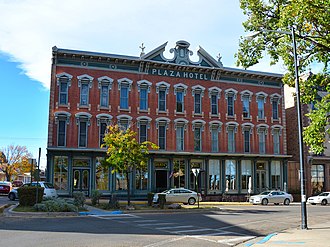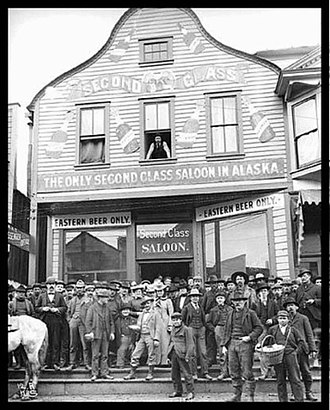Wyatt Earp and his Women–Places throughout the West
Leave a commentFebruary 1, 2024 by pamelanowak
Originally published Dec. 11, 2021
Wyatt Earp and his women were largely transient, remaining in the same locale for only a few years at a time and often relocating seasonally in tandem with Wyatt’s seasonal law officer jobs. In the off-season, Wyatt and Mattie often followed the gambling circuit. Wyatt and Josie spent time gambling, prospecting, and residing in California. This week, I’ll touch on the places they called home for brief periods and what they did there. While you’ll see a few of these places in NECESSARY DECEPTIONS (release date February 16, 2022), their ventures were far more varied than I could accommodate in the plot.
Wyatt and Mattie, Jim and Bessie lived in various towns in Kansas besides Wichita and Dodge City. Bessie and Jim briefly farmed in Atchison County. Jim won a prize at a county fair (along with two partners) for a hide. It may be that Mattie and Wyatt and Morgan joined them for a time after Wyatt lost his job in Wichita. Wyatt’s biographers claimed Wyatt spent time as a buffalo hunter. I chose to incorporate that possibility into my plot by having the brothers leave the women to do just that. The actual facts are vague for that time period but is seemed like something they would do.
During the winters that Earp worked in Kansas, he and Mattie would often venture to Texas on the gambling circuit. Between 1876 and 1879, they spent at least two winters in the Fort Worth area with James and Bessie. The city was established at an army outpost in 1849, one of several intended to protect settlers. The city itself grew up when the fort was moved to the top of the bluff. With the advent of the cattle industry, Fort Worth’s location on the Chisholm Trail stimulated growth. By 1876, the Texas and Pacific Railway was completed and growth swelled. Saloons, gambling halls, and brothels were plentiful, especially in “Hell’s Half-Acre.” Most respectable citizens avoided that part of town and arrests were plentiful. Gambling halls, however, were often permitted to operate without interference due to the money they brought into town. Jim ad Bessie had a house at the edge of Hell’s Half Acre. Jim tended bar at the respectable Cattlemen’s Exchange while Bessie pursued the prostitution trade. During Wyatt and Mattie’s visits, Wyatt gambled; Mattie may (or may not) have joined Bessie in the brothel trade.
Another Texas stop for Wyatt was Fort Griffin. Like Fort Worth, it was created as a defensive fort, though much later, in 1867. During its fourteen-year existence, the fort itself consisted primarily of log structures with a few stone buildings. A town grew up on the flats below the fort, serving as a jump-off point for settlers headed west. Saloons provided entertainment for the soldiers and for the transients passing through the area. Once the area became a stop-off point for cattle drives headed to Dodge City, vice was heavy. Earp passed through, as did Doc Holliday and other well-known figures including Pat Garret, Big Nose Kate, and Bat and Jim Masterson. In my novel, Mattie joined Wyatt on one of the trips, the pair stopping at the well-known Shanssey’s Cattle Exchange Saloon (spellings vary).
Yet another stop on the gambling circuit was Las Vegas, New Mexico. The town was established in 1835 as part of t Mexican land grant and prospered as a stop on the Santa Fe Trail. It was proclaimed part of the United Staes in 1846 and was part of the Taos Revolt in 1847. The arrival of the railroad brought both respectable businessmen and saloons, gamblers, and lawlessness. Most of the underside settled along the easter side to the town. Doc Holliday and Big Nose Kate spent time in the town and Earp is said to have spent at least parts of his winters gambling there. When Wyatt and Mattie, Jim and Bessie made their way to Tombstone, they traveled through Las Vegas.
After the events at the OK Corral in Tombstone and the subsequent murder of Morgan Earp, Wyatt left his women to seek revenge. His “Vendetta Ride” led to arrest warrants and he fled Arizona Territory. During the months he spent avoiding arrest, he briefly visited New Mexico and Colorado along with Doc Holliday, his brother Warren, and the others who had participated in chasing down those they believed responsible for the murder. The group traveled east to Silver City, New Mexico then northward to Albuquerque. The city had been founded in 1706 as an outpost on the El Camino Real but had been the home of Native Americans for centuries before that with around 20 Tiwa pueblos in the area. The city was the site of a garrison and quartermaster depot in the Civil War and along both stage and train routes when Earp passed through. While in Albuquerque, he argued with Doc Holliday about Josephine Marcus and the two parted company.
From Albuquerque, where Wyatt had joined old friend Bat Masterson, the remaining members of the group journeyed into Colorado. Earp ran a faro game in Trinidad at Masterson’s saloon. Trinidad was close to the Santa Fe Trail and the town was founded after a coal strike in the area in 1862. The railroad reached the growing town in 1878 and fostered its growth. Masterson was briefly marshal of the town. Earp stayed for several weeks then left with the others for Gunnison, Colorado. Gunnison was a mining town named for explorer John W. Gunnison; when the railroad arrived in 1880, growth expanded. When Wyatt et al arrived there in May 1882, they set up camp on the outskirts and allegedly sold fake gold rocks to an unsuspecting German visitor. Doc Holliday later arrived in the area. He and Wyatt saw each other one final time in 1886 at the Windsor Hotel before Doc died of tuberculosis.
By mid-1882, Earp had made his way to California. Newspapers in San Diego and San Franciso reported both Virgil and Wyatt were in San Francisco. Wyatt dealt faro for awhile, then worked at a horse stable in Santa Rosa. At some point, he and Josephine become a permanent couple with Josie taking Earp as her last name and lived on and off in the area for years. Wyatt and Josephine owned four saloons and gambling houses in San Diego between 1887 and 1896, all in respectable parts of town and is said to have made up to $1,000 per night in profits. He also owned the Oyster Bar (which hosted a brothel upstairs). He lost all the businesses for failure to pay taxes. Wyatt gained a reputation as a sportsman and gambler with some reports saying he owned race-horses (other reports indicate he rented them). He refereed boxing matches (including the infamous Fitzsimmons-Sharkey fight), gambled on them, and were close friends with Hollywood actors such as Tom Mix and Lucky Baldwin, noted theatre owner (whom Josie may have known for years). The couple lived in Los Angeles during their later years and Wyatt was hired by the Los Angeles Police Department to carry out various tasks “outside the law.” He was also arrested for trying to fleece a man in a faro game but charges were dropped because money had not changed hands.
When not in California, Wyatt and Josie often spent time prospecting and chasing gambling wealth in mining towns. After nine months in San Francisco, they ventured to Silverton, Colorado for a brief time. They also made their way to Eagle City, Idaho along with James and Bessie Earp. Wyatt prospected for gold and he and Jim partnered in the purchase of a large white circus tent in which they operated a dance hall and saloon which they named The White Elephant. In my novel, I chose to give a role in its operations to Josie and Bessie. Some sources suggest Wyatt served as a deputy sheriff as well. Some years later, Wyatt was accused of instigating a real-estate fraud/lot jumping scheme there. When the mining died down in the area, Josie and Wyatt went on to San Diego.
The discovery of gold in the Klondike drew Wyatt and Josie to Alaska in 1897. They planned to open a gambling house in Dawson but spent only a month there before heading north. Whey wintered in Rampart then continued toward St. Michael where Wyatt managed a store. After a short time, they moved on to Nome where they rented a wooden shack and partnered with Charles Hoxie to build the Dexter Saloon. The posh two-story building was known for its luxury and second-floor “clubrooms.” In later years, as Wyatt’s biographies were being written, Josie omitted their role in the brothel. Wyatt made a tidy profit during the time in Nome and was arrested there twice.
The couple left Nome for Seattle where they also planned to open a saloon and gambling room. They arrived in late 1899. Newspapers reported Wyatt ask wearing guns and having a reputation as a “bad man.” Earp faced stiff competition and local politics eventually closed his highly-profitable saloon. Wyatt and Josie returned for a brief sojourn to Los Angeles then returned north to Nome. In 1901, they sold their interest in the Dexter and left Alaska permanently. Reports say they had amassed around $80,000 (today, about $2.5 million or more).
Wyatt and Josie Earp also spent considerable time in other mining areas. After departing Nome, they ventured to Tonopah, Nevada and opened The Northern Saloon. Wyatt also pursued mining and served as a deputy U.S. Marshal. From there, they moved to Goldfield, Nevada where they joined Virgil and Allie Earp. Wyatt worked as a pit boss in the area and later at mines in the Death Valley area. He discovered several gold deposits of his own and filed on more than 100 claims in the Vidal, California area. They bought a small house in Vidal and summered in Los Angeles. Winters were spent working their claims.





